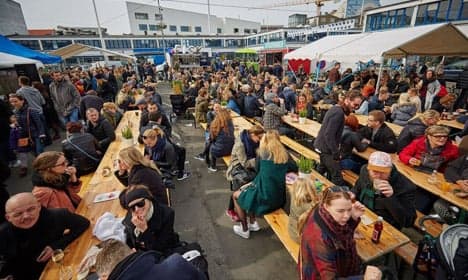To combat loneliness, Danes and expats share a meal

Danes and expats alike are invited to break their solitude and enjoy a nice meal together.
Looking for weekend plans? Want to meet new people? On Sunday, head to Kødbyens Mad & Marked to enjoy a meal with fellow expats and friendly Danes as part of a nationwide effort to combat loneliness and solitude.
Dubbed 'The World Eats Together', Sunday's event is an extension of the 'Denmark Eats Together' (Danmark Spiser Sammen) campaign, a series of communal meals meant to bring people together in light of a recent poll that showed nearly one in four people in Denmark eats alone.
Organized by the Movement Against Solitude (Folkebevægelsen mod Ensomhed), the eating events are seen as a helpful tool in combating loneliness.
Stine Aagaard, communications coordinator for Kødbyens Mad og Marked, says solitude is a real problem both for Danes and those in the international community who have had a hard time making friends in their new home.
“In Denmark a lot of people feel lonely. We thought the expat angle would be interesting because of the many expats who work in Denmark but don't necessarily meet up with each other or with Danish people," she told The Local.
The Nationwide Movement Against Solitude organizes not only this event, but also a range of other events, all with the same goal.
“Hopefully expats will show up and meet each other at the market. It’s our mission to gather both Danish people and expats because we believe that it’s always a strength to meet new people and new cultures," said Aagaard.

If that's not enough to draw internationals out to the trendy Kødbyen district on Sunday, attendees can expect to find plenty of stalls offering expat-only special offers on drinks and food, with prices ranging from 100-150 kroner for a meal.
This is the first time an expat-specifc communal eating event has been planned and organizers expect between 100 and 200 guests, although a Facebook page for the event has over 750 people marked as “interested”.
“Bottom line we also hope that expats will enjoy the market, have a great food experience and maybe visit a place in Copenhagen they don’t visit that often,” said Aagaard.
So be sure to mark your calendar, ‘The World Eats Together’ runs from 10am until 6pm on Sunday at Flæsketorvet in Copenhagen's Kødbyen district.
Comments
See Also
Looking for weekend plans? Want to meet new people? On Sunday, head to Kødbyens Mad & Marked to enjoy a meal with fellow expats and friendly Danes as part of a nationwide effort to combat loneliness and solitude.
Dubbed 'The World Eats Together', Sunday's event is an extension of the 'Denmark Eats Together' (Danmark Spiser Sammen) campaign, a series of communal meals meant to bring people together in light of a recent poll that showed nearly one in four people in Denmark eats alone.
Organized by the Movement Against Solitude (Folkebevægelsen mod Ensomhed), the eating events are seen as a helpful tool in combating loneliness.
Stine Aagaard, communications coordinator for Kødbyens Mad og Marked, says solitude is a real problem both for Danes and those in the international community who have had a hard time making friends in their new home.
“In Denmark a lot of people feel lonely. We thought the expat angle would be interesting because of the many expats who work in Denmark but don't necessarily meet up with each other or with Danish people," she told The Local.
The Nationwide Movement Against Solitude organizes not only this event, but also a range of other events, all with the same goal.
“Hopefully expats will show up and meet each other at the market. It’s our mission to gather both Danish people and expats because we believe that it’s always a strength to meet new people and new cultures," said Aagaard.

If that's not enough to draw internationals out to the trendy Kødbyen district on Sunday, attendees can expect to find plenty of stalls offering expat-only special offers on drinks and food, with prices ranging from 100-150 kroner for a meal.
This is the first time an expat-specifc communal eating event has been planned and organizers expect between 100 and 200 guests, although a Facebook page for the event has over 750 people marked as “interested”.
“Bottom line we also hope that expats will enjoy the market, have a great food experience and maybe visit a place in Copenhagen they don’t visit that often,” said Aagaard.
So be sure to mark your calendar, ‘The World Eats Together’ runs from 10am until 6pm on Sunday at Flæsketorvet in Copenhagen's Kødbyen district.
Join the conversation in our comments section below. Share your own views and experience and if you have a question or suggestion for our journalists then email us at [email protected].
Please keep comments civil, constructive and on topic – and make sure to read our terms of use before getting involved.
Please log in here to leave a comment.